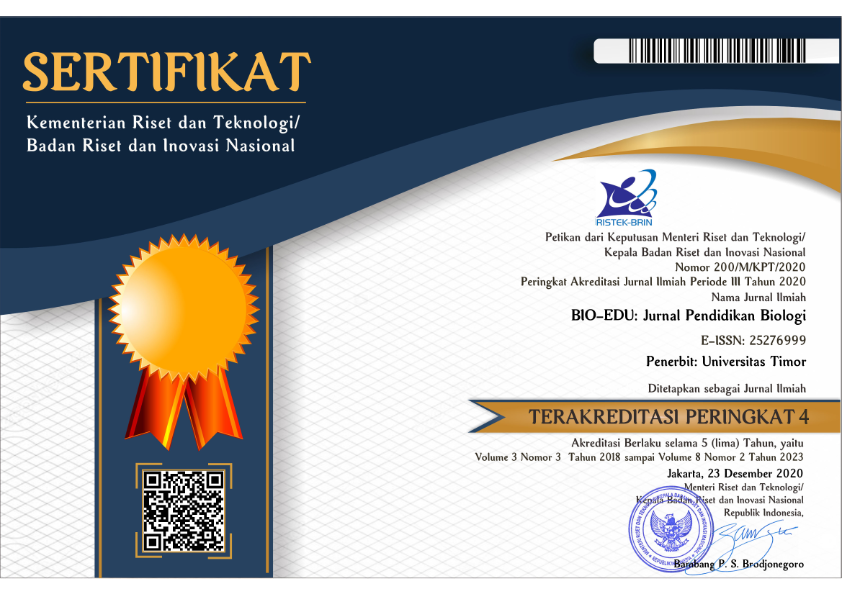PENGARUH EKSTRAK KULIT JERUK KALAMANSI TERHADAP PERTUMBUHAN BAKTERI SALMONELLA TYPHI DAN SUMBANGANNYA PADA PEMBELAJARAN BIOLOGI SMA
Abstract
Kalamansi orange (Citrus microcarpa Bunge.) has the potential as a source of antimicrobials because the skin of the fruit contains flavonoid compounds, tannins, and alkaloids which have been shown to be able to inhibit the growth of gram-negative bacteria. This study aimed to obtain information on the effect of ethanolic extract of kalamansi orange peel (C. microcarpa Bunge.) on the growth of Salmonella typhi bacteria land the minimum inhibitory concentration of ethanolic extract of kalamansi orange peel (C. microcarpa Bunge.) on the growth of S. ltyphi bacteria. Experimental research with a completely randomized design, the results were analyzed using the One Way ANOVA test. Calamansi orange peel ethanol extract with concentrations of 0%, 5%, 7.5%, 10%, 12.5%, and 15% was tested for antibacterial activity against the growth of S. typhi bacteria using the disc diffusion method. The parameters observed were the diameter of the inhibition zone formed around the lpaper disc. The results of this study showed that ethanol extract of kalamansi orange peel (C. microcarpa Bunge.) had a significant effect on the growth of S. typhi bacteria, with a 95% confidence level and minimum inhibitory concentration (MIC) of ethanolic extract of kalamansi orange peel (C. microcarpa Bunge.) on bacterial growth. S. typhi was at a concentration of 10%, to be precise, MIC was at a concentration of 5% with an average inhibition zone diameter of 5.27 mm. The results of this study were donated in the form of student worksheets and related their role in life in the biology subject of SMA class X even semester
References
Davis, W. W., & Stout, T. R. (1971). Disc plate method of microbiological antibiotic assay. Applied Microbiology, 22(4), 659–665.
Gunawan, D. O., Indriani, L., & Dewi, M. (2020). Evaluasi pemberian antibiotik pada pasien demam tifoid di instalasi rawat inap rumah sakit Azra Kota Bogor. Fitofarmaka Jurnal Ilmiah Farmasi, 10(1), 54–64.
Hanizar, E., & Sari, D. N. R. (2018). Aktivitas antibakteri Pleurotus ostreatus varietas grey oyster pada Staphylococcus aureus dan Pseudomonas aeruginosa. E-Jurnal Pustaka Kesehatan, 6(3), 387–392.
Harsojuwono, B. A., Arnata, I. W., & Puspawati, G. A. K. D. (2011). Rancangan Percobaan. Lintas Kata Publishing.
Hasnawati. (2006). Pendekatan contextual teaching learning hubungannya dengan evaluasi pembelajaran. Jurnal Ekonomi Dan Pendidikan, 3(1), 53–62.
Kemenkes RI. (2006). Pedoman Pengendalian Demam Tifoid. Kemenkes RI.
Kindangen, G. D., Lolo, W. A., & Yamlean, P. V. Y. (2018). Uji aktivitas anti bakteri minyak atsiri kulit buah jeruk kalamansi (Citrus microcarpa Bunge.) terhadap bakteri Staphylococcus aureus dan Escherichia coli. Jurnal Ilmiah Farmasi, 7(4), 62–68.
Kumoro, A. C. (2015). Teknologi ekstraksi senyawa bahan aktif dari tanaman obat. Plantaxia.
Mubarak, F., Sartini, S., & Purnawanti, D. (2018). Effect of ethanol concentration on antibacterial activity of bligo fruit extract (Benincasa hispida Thunb.) to Salmonella typhi. IJPST, 5(3), 76–81.
Noviyanty, Y., Hepiyansori, & Ningsih, Y. P. (2019). Identifikasi senyawa tanin dari ekstrak etanol kulit buah jeruk kalamansi (Citrus x microcarpa Bunge). Jurnal Ilmiah Farmacy, 6(1), 44–52.
Pelczar, M. J., & Chan, Jr. E. C. S. (2008). Dasar-dasar mikrobiologi jilid 2. Universitas Indonesia Pressc (UI-Press).
Raini, M. (2016). Antibiotik golongan fluorokuinolon: Manfaat dan kerugian. Media Litbangkes, 26(3), 163–174.
Riwanti, P., Izazih, F., & Amaliyah. (2020). Pengaruh perbedaan konsentrasi etanol pada kadar flavonoid total ekstrak etanol 50,70, dan 96% Sargassum polycystum dari Madura. Journal of Pharmaceutical-Care Anwar Medika, 2(2), 35–48.
Salim, H. H. U., & Soleha, T. U. (2017). Pengaruh aktivitas antimikroba ekstrak bawang putih (Allium sativum) terhadap bakteri gram positif (Staphylococcus aureus) dan gram negatif (Escherichia coli) secara in vitro. Medula, 7(5), 66–70.
Sumayyah, S., & Salsabila, N. (2017). Obat tradisional: Antara khasiat dan efek sampingnya. Majalah Farmasetika, 2(5), 1–4.
Supriningrum, R., Fatimah, N., & Purwanti, Y. E. (2019). Karakteristik spesifik dan non spesifik ekstrak etanol daun putat (Planchonia valida). Al Ulum Jurnal Sains Dan Teknologi, 5(1), 6–12.
Suteja, I. K. P., Rita, W. S., & Gunawan, I. W. G. (2016). Identifikasi dan uji aktivitas senyawa flavonoid dari ekstrak daun trembesi (Albizia saman (Jacq.) Merr) sebagai antibakteri Escherichia coli. Jurnal Kimia, 10(1), 141–148.
Wulandari, M., Idiawati, N., & Gusrizal. (2013). Aktivitas antioksidan ekstrak N-heksana, etil asetat dan metanol kulit buah jeruk sambal (Citrus microcarpa Bunge.). Jkk, 2(2), 90–94.
Yulliasri, J., Praptiwi, & Agusta, A. (2000). Komponen kimia dan efek antibakteri minyak atsiri kulit buah dan daun jeruk kasturi (Citrus microcarpa Bunge.). Majalah Farmasi Indonesia, 11(1), 77–85.
Yusmaniar, Wardiyah, & Nida, K. (2017). Mikrobiologi dan parasitologi. Kemenkes RI.
Zeniusa, P., Ramadhian, M. R., Nasution, S. H., & Karima, N. (2019). Uji daya hambat ekstrak etanol teh hijau terhadap Escherichia coli Secara in vitro. Majority, 8(2), 136–143.
Copyright (c) 2022 BIO-EDU: Jurnal Pendidikan Biologi

This work is licensed under a Creative Commons Attribution-ShareAlike 4.0 International License.
The Authors submitting a manuscript do so on the understanding that if accepted for publication, the copyright of the article shall be assigned to BIO-EDU: Jurnal Pendidikan Biologi and Departement of Biology Education, Universitas Timor as the publisher of the journal. Copyright encompasses rights to reproduce and deliver the article in all form and media, including reprints, photographs, microfilms, and any other similar reproductions, as well as translations.
BIO-EDU journal and Departement Biology Education, Universitas Timor, and the Editors make every effort to ensure that no wrong or misleading data, opinions, or statements be published in the journal. In any way, the contents of the articles and advertisements published in BIO-EDU are the sole and responsibility of their respective authors and advertisers.
Users of this website will be licensed to use materials from this website following the Creative Commons Attribution-ShareAlike 4.0 International License.



















